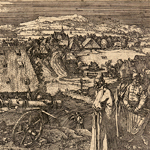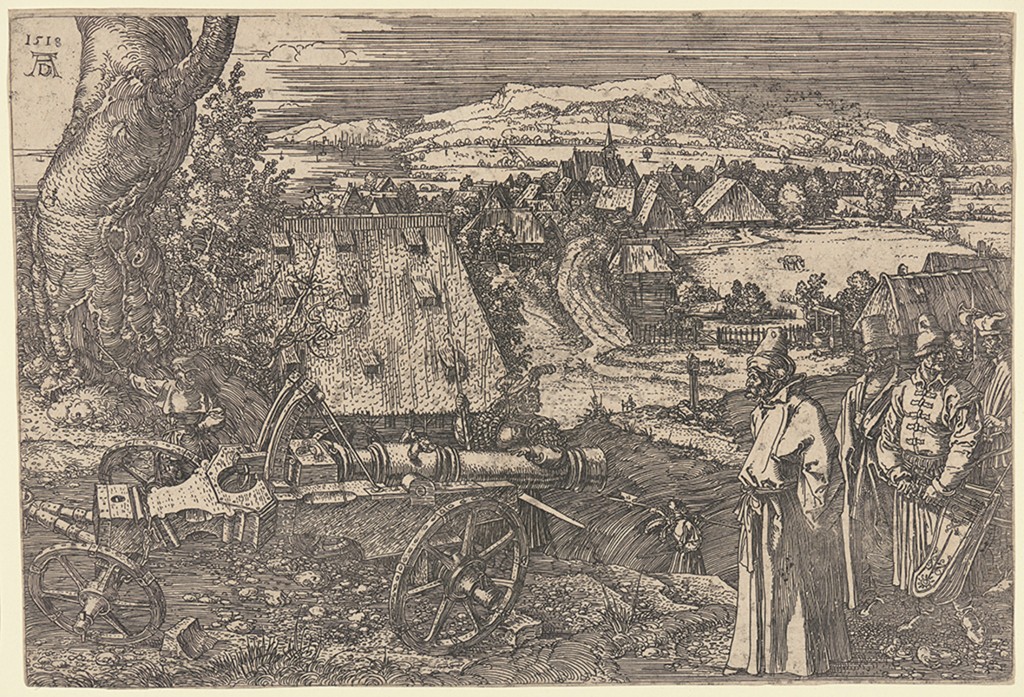FROM THE VAULT: HIGHLIGHT FROM THE DAVISON ART CENTER


In 1518, the painter and printmaker Albrecht Dürer (1471–1528) completed his sixth and final etching, Landscape with Cannon. He never returned to the technique of etching again, and scholars have long puzzled why Dürer stopped using this printmaking method. Close examination of Landscape with Cannon raises questions about etching, as well as orientalism, military might, and the rise of landscape as an independent subject for art.
Etching was first developed in Augsburg as early as 1500 in the workshop of Daniel Hopfer (ca. 1470–1536). It was derived from techniques used to decorate armor, and this may explain why the first etchings were created using iron plates, instead of the copper plates preferred for engravings. To prepare an etching, the plate would be covered with a waxy varnish, and then the artist would draw with a stylus or needle through the varnish, revealing the plate below. When the drawing was complete, the plate was immersed in a mordant or corrosive liquid, which ate away the plate wherever the varnish had been removed. This created grooves, which could be inked and printed on paper.
Etching offered Dürer a technique that was faster and more spontaneous than engraving on copper plates. In addition, the lines looked much like the lines in his numerous pen-and-ink drawings. Yet this wasn’t enough to maintain his interest. In the early 16th century, collectors were interested in highly finished works, not in spontaneity. There was no market for pen-and-ink drawings or for etchings. An even greater problem was the way in which the iron plates rusted, leaving pits in the plate that caught the ink and left unintended marks on the prints. The DAC impression has numerous speckles from rust damage near the monogram “AD” and throughout the roof of the barn.
The subject of Landscape with Cannon is as enigmatic as the choice of technique. A single cannon rests at the top of a road leading to a quiet village. The town is based on a drawing by Dürer of Kirchehrenbach, located only 25 miles north of Nuremberg, Dürer’s home town. An oak tree at the left frames this vision of the strength, prosperity, and peace of the German landscape.
Standing with his pike near the front of the cannon is a Landsknecht, one of the professional foot soldiers from the army of Holy Roman Emperor Maximilian I. The cannon is identified with the coat of arms of the Imperial city of Nuremberg. Facing these representatives of imperial military power are four men recognizable as foreigners. One has a hat similar to the börk or triangular hat worn by the Janissaries, the elite Ottoman guards. Another wears a coat with repeated clasps and may represent a Mamluk soldier, from the ruling military class in Egypt.
Ever since the fall of Constantinople to the Ottoman Empire in 1453, Christendom had been fascinated and troubled by images of Islamic others. In 1518, the year this print was created, Dürer’s patron, Emperor Maximilian I, had issued a call for a new crusade. Just 11 years later, in 1529, the Ottomans besieged Vienna (unsuccessfully) for the first time.
Landscape with Cannon presents a meeting between two cultures, set within an idyllic German landscape. But the details don’t quite add up. Who are these people, and why is there only one cannon? In this print, Dürer achieves neither the technical brilliance nor the allegorical sophistication of his most famous Meisterstiche or “master engravings.” Yet we glimpse a master artist willing to struggle with a new technique and a new subject. —CLARE ROGAN, Curator of the Davison Art Center.
